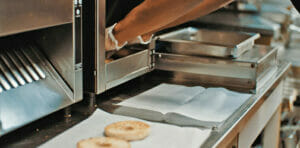Space is limited in every restaurant for both the front of the house and the kitchen.
As restaurants are moving into higher density areas, the rent for these locations continues to increase — forcing the brands to find a way to generate enough revenue to afford to serve these populated areas.
Since more room for diners could translate into more dollars for operators, kitchens often bear the burden of these limitations.
The kitchen is still the lifeblood of the restaurant, however, and needs to be efficient and able to keep up with throughput demands.
Because of this complex situation, operators are turning to their equipment manufacturers for help. They are looking for equipment with a smaller footprint and multi-functional equipment that can handle several tasks and space-saving designs, such as equipment that can be suspended above or mounted below a prep line.
Customized equipment can help a facility maximize space while meeting other needs such as creating a consistent guest experience and helping to facilitate changing menu offerings.
Antunes works with customers to understand their unique needs and kitchen challenges and uses this information to develop custom solutions for their operations.
One example of Antunes’ commitment to helping customers succeed is demonstrated in their partnership with a quick-service chicken restaurant chain.
Situation
The chain wanted a new toasting system that provides a better quality toast and be able to toast additional items for planned menu expansion. However, the new toasting system needed to fit into the same footprint as the existing toaster so that operators would not have to reconfigure their prep lines to accommodate new equipment.
Execution
Building on a toaster concept that had been previously tested by the chain, Antunes began the development process. Prototypes were evaluated by the manufacturer and in the field, and following an extensive review, two toaster units designed specifically for the restaurant were produced.
Results
Antunes completed the chain-wide rollout of two custom toasters for the chain: the VCT-2 vertical contact toaster and the RT-2 radiant toaster — the first pieces of Antunes equipment the restaurant rolled out to their operations.
The VCT-2 and RT-2 are used side-by-side in the prep line; the VCT-2 is used to toast buns for the lunch and dinner menu, while the RT-2 is used for breakfast items. Additionally, because of their compact footprint — each measuring 13 inches wide — the two toasters fit into the same space occupied by the previous toaster.
“We worked closely with the chain to develop toasters that would provide a better quality toast on the buns and breakfast items, while fitting into the allotted space and giving them the flexibility to handle future menu innovations,” said Tony Vassos, Director of Product Management & Marketing for Antunes. “We were so pleased with the results that we now offer this equipment to an expanded foodservice market.”
To see more examples of how Antunes creates equipment to solve customer challenges — from addressing space limitations to creating product consistency — check out our library of case studies.


 Antunes Announces Installation and Service Program for Water Filtration Equipment
Antunes Announces Installation and Service Program for Water Filtration Equipment